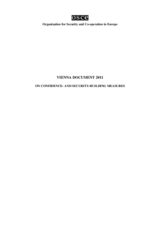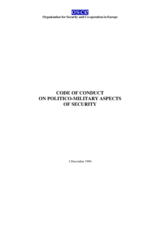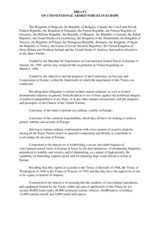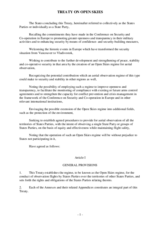-
Our work
-
Fields of work
- Arms control
- Border management
- Combating trafficking in human beings
- Conflict prevention and resolution
- Countering terrorism
- Cyber/ICT Security
- Democratization
- Economic activities
- Education
- Elections
- Environmental activities
- Gender equality
- Good governance
- Human rights
- Media freedom and development
- Migration
- National minority issues
- Policing
- Reform and co-operation in the security sector
- Roma and Sinti
- Rule of law
- Tolerance and non-discrimination
- Youth
- Field operations
- Projects
-
Meetings and conferences
- Summit meetings
- Review Conferences
- Ministerial Council meetings
- Plenary meetings of the Permanent Council
- Plenary Meetings of the Forum for Security Co-operation
- Security Review Conferences
- Annual Implementation Assessment Meetings
- Economic and Environmental Forum
- Economic and Environmental Dimension Implementation Meetings
- Human rights meetings
- Media conferences
- Cyber/ICT security conferences
- Conference of the Alliance against Trafficking in Persons
- Gender equality conferences
- Annual OSCE Mediterranean conferences
- Annual OSCE Asian conferences
- Partnerships
-
Fields of work
-
Countries
- All
-
Participating States
- Albania
- Andorra
- Armenia
- Austria
- Azerbaijan
- Belgium
- Belarus
- Bosnia and Herzegovina
- Bulgaria
- Canada
- Croatia
- Cyprus
- Czechia
- Denmark
- Estonia
- Finland – OSCE Chairpersonship 2025
- France
- Georgia
- Germany
- Greece
- Holy See
- Hungary
- Iceland
- Ireland
- Italy
- Kazakhstan
- Kyrgyzstan
- Latvia
- Liechtenstein
- Lithuania
- Luxembourg
- Malta
- Moldova
- Monaco
- Mongolia
- Montenegro
- The Netherlands
- North Macedonia
- Norway
- Poland
- Portugal
- Romania
- Russian Federation
- San Marino
- Serbia
- Slovakia
- Slovenia
- Spain
- Sweden
- Switzerland
- Tajikistan
- Türkiye
- Turkmenistan
- Ukraine
- United Kingdom
- United States of America
- Uzbekistan
- Asian Partners for Co-operation
- Mediterranean Partners for Co-operation
-
Structures and institutions
- Chairpersonship
-
Secretariat
- Secretary General
- Office of the Secretary General
- Conflict Prevention Centre
- Transnational Threats Department
- Office of the Special Representative and Co-ordinator for Combating Trafficking in Human Beings
- Office of the Co-ordinator of OSCE Economic and Environmental Activities
- Gender Issues Programme
- Opportunities for Youth
- Department of Human Resources
- Department of Management and Finance
- Office of Internal Oversight
- Documentation Centre in Prague
- Institutions
-
Field operations
- Presence in Albania
- Centre in Ashgabat
- Programme Office in Astana
- Programme Office in Bishkek
- Mission to Bosnia and Herzegovina
- Programme Office in Dushanbe
- Mission in Kosovo
- Mission to Moldova
- Mission to Montenegro
- Mission to Serbia
- Mission to Skopje
- Project Co-ordinator in Uzbekistan
- Closed field activities
- Parliamentary Assembly
- Court of Conciliation and Arbitration
- Organizational structure
- About us
Vienna Document
22 December 2011
First adopted in 1990, the Vienna Document contains a set of confidence- and security-building measures (CSBMs) in the military realm and represents one of the key pillars of European security architecture. The CSBMsCSBMs
Confidence- and security-building measures provide for an annual exchange of military information, prior notification and observation of major military activities, inspections and evaluations, and military-to-military contacts.
According to the ‘Final Provisions’ (Chapter XII) of the Vienna Document 2011, every five years—or more frequently—the participating States are to organize a special Forum for Security Co-operation meeting to update and reissue the Vienna Document. Since its adoption, the Vienna Document has been reissued four times (1992, 1994, 1999 and 2011). After 2011, it was updated several times by the Forum, effectively changing several provisions in the document.
Code of Conduct
3 December 1994
The Code of Conduct on Politico-Military Aspects of Security is one of the most important norm-setting instruments developed by the OSCE in the post-Cold War era. It is a stand-alone, politically binding instrument that broke new ground with regard to democratic political control of armed forces and the use of armed forces both in times of peace and conflict. It links the OSCE’s politico-military dimension with its human dimension of security.
As part of the Code’s regime, the participating States annually exchange information in the form of answers to an extensive questionnaire on democratic control of their armed and security forces, inter and intra-State practices and other procedures related to the issue, including the women, peace and security agenda.
CFE Treaty
Treaty on Conventional Armed Forces in Europe, 19 November 1990
The Treaty on Conventional Armed Forces in Europe, also known as the CFE Treaty, has been regarded as a cornerstone of European stability and security, “from the Atlantic to the Urals”. It established comprehensive, legally binding limits on key categories of conventional military equipment. The Treaty was the product of five years of negotiation on force limitations conducted by NATO and Warsaw Pact States within the framework of the then-CSCE.
The Treaty entered into force on 9 November 1992, following the ratification by 30 states (the then-16 NATO members, eight former USSR republics with territory west of the Urals—Armenia, Azerbaijan, Belarus, Georgia, Kazakhstan, Moldova, Russian Federation and Ukraine—and the six former Warsaw Pact members Bulgaria, Czech Republic, Slovakia, Hungary, Poland and Romania. In 2023, the Russian Federation withdrew from the Treaty. In the period since then, a large number of members of the Joint Consultative Group—the Treaty’s implementing body—have suspended the operation of the CFE.
The key goal of the Treaty was to establish a military balance between the two alliances at lower armaments levels. In the early years after ratification, the successful destruction of approximately 50,000 weapon systems and the creation of an unprecedented system of verification and transparency took place under the Treaty.
Treaty on Open Skies
24 March 1992
The Treaty on Open Skies established a regime of unarmed aerial observation flights over the territory of its signatories.
The Treaty permits each State Party to conduct short-notice, unarmed reconnaissance flights over the others' entire territories to take pictures and collect data on military forces and activities. It establishes a regime to strengthen mutual confidence, openness and transparency of military forces and their activities. The Treaty was ratified by 35 State Parties but several States have withdrawn from it since 2020.
Article IV of the Dayton Peace Accords
14 June 1996
Article IV of the Dayton Peace Accords provided the framework for negotiations of a sub-regional arms control agreement, which was concluded in Florence on 14 June 1996. It engaged the three parties within Bosnia and Herzegovina as well as Croatia and Serbia and Montenegro.




